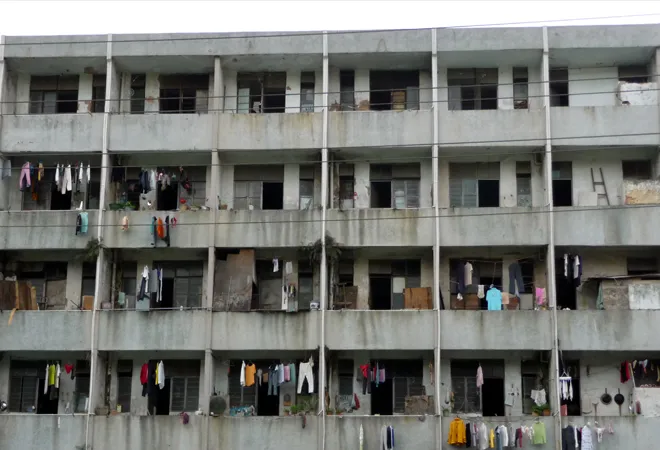-
CENTRES
Progammes & Centres
Location
The appraisal of select aspects of China’s urbanisation strategy and the progress in implementation indicate a massive urban transformation.

Image Source: Flickr user Chris — CC BY-NC 2.0
This is the sixtieth part in the series The China Chronicles.
Read all the articles here.
China, the world’s most populous country, is urbanising in a big way. The government recognises the opportunities and benefits of urbanisation, and working towards promoting and managing urban growth in an equitable and orderly manner.
A National New Urbanisation Plan (2014-2020) and the 13th Five-Year Plan for Economic and Social Development (2016-2020) reveal China’s commitment to stepping up the pace of new urbanisation. To ensure planned urban growth, a variety of policy and planning measures are underway. It is expected that China’s urbanisation rate (i.e., proportion of population living in urban areas) will grow from 58.52 per cent in 2017 to nearly 70 per cent by 2030.
As witnessed across the world, the pressure of a large population can be severely felt on urban government agencies, as well as various urban sectors — employment, housing, mobility, water and sanitation, environment, and so on. Urban government’s preparedness to grapple with the challenges of urbanisation can make a big difference in ensuring good quality of life to residents. As explained below, China aims to create and offer such an environment.
This measure allows rural migrants to settle in urban areas with families and enjoy the same public services and rights as other urban residents, which they were not receiving previously. Despite the policy reform, it is still difficult for many rural migrants to obtain urban residency (household registration) and welfare entitlements particularly in large cities, implying that their hardships are not yet over. The local governments have introduced tough regulations, and the applications are vetted on criteria such as education level, tax payments, and work experience. Those acquiring low scores are not eligible for urban residency. The government is reportedly working towards relaxing the criteria with the aim of improving people’s quality of life and promoting urbanisation.
Of the 19 city clusters identified for development, strategy and investment plans for 11 clusters are prepared. In the Beijing-Tianjin-Hebei cluster, a science park is set up that houses many enterprises (science, technology, healthcare, finance), which in turn have established over 6,100 subsidiaries in the region. By integrating innovative, industrial and financial resources available in the region, many enterprises are benefitting, and the plan is to improve the overall competitiveness and create an excellent city cluster. Thus, city clusters will provide new opportunities in the region, as has been experienced in the US and Japan. Analysts emphasise that for the city cluster model to succeed, the participating governments should have “authority over planning, investment, fiscal management of revenues and budgets.” Further, steps have been taken to unlock the potential of small towns and cities in the region and to make these attractive. For example, in the city region of Wuxi (near Shanghai), is where ancient monuments, buildings, and artefacts are protected and preserved. This rich heritage attracts a large number of domestic and foreign tourists.
Over 200 smart city pilot projects are underway in China to enhance urban living and management. A four-layered architecture to guide future development of cities is under implementation and investments are being made in technologies, such as Internet of Things (IoT) and cloud computing. In the first stage (sensing layer), objects are identified and real-world information is collected through sensing equipment. The massive information collected is transmitted (transmission layer) to a processing centre (processing layer) for analysis. In the final stage (application layer), smart solutions are applied in sectors, such as environment, homes, healthcare, education, water, security, traffic, food safety, agriculture, and electricity. For example, Xinjian’s water system based on cloud computing and IoT allows for monitoring river water flow and water quality to quickly address the problem of flooding and water pollution. Scholars at Wuhan University observe gains in smart technology and intelligent planning. It is suggested that: “policy guidance and top design at the national level must come early in the project to avoid huge losses; national IoT and information management standards must be developed to integrate smart cities as their numbers grow; and information security must be strengthened.”
City governments in China are taking steps to increase supply of residential houses by allocating new land for house construction, and establishing state-owned leasing companies. Efforts are also being made to develop a long-term rental market. Of the total new land supply, 30 per cent will be allocated for rental housing and housing with shared ownership. An effective housing price control mechanism has been established to maintain price stability. Speculative demand is curbed through “restrictions on house purchases and increased minimum down payments required for mortgages.”
Shanghai, Beijing and Guangzhou have set future population targets. The three city governments are trying to control further population growth by introducing measures such as relocation of some government agencies and functions to newly created cities. This decision is taken to maintain desirable living conditions (or manage “big city disease”), and reduce pressure on city resources. The governments realise that such steps will help in developing these cities as globally influential cities. The move to set aggressive targets is widely criticised and seen as unreasonable. Observers say, “Shanghai would need a young and highly skilled workforce if it is to stay competitive and innovative,” and that if such measures are implemented “migrant workers and the city’s poor would suffer the most.”
This appraisal of select aspects of China’s urbanisation strategy and the progress in implementation indicate a massive urban transformation. To summarise, efforts are being made to address the problems in existing cities. Superior infrastructure, services and use of technology are already visible in many cities. There is also a plan to decongest most populated cities. Work on development of new urban centres and city clusters at the regional level is underway to accommodate future urban growth and address regional development imbalances. In this endeavour, importance is being given to application of principles of smartness and good governance.
As China, moves forward in establishing world-class urban centres that offer high quality urban life, greater efforts must be made to ensure China’s neglect of social, cultural and environmental problems are also overcome.
The views expressed above belong to the author(s). ORF research and analyses now available on Telegram! Click here to access our curated content — blogs, longforms and interviews.

Rumi Aijaz is Senior Fellow at ORF where he is responsible for the conduct of the Urban Policy Research Initiative. He conceived and designed the ...
Read More +